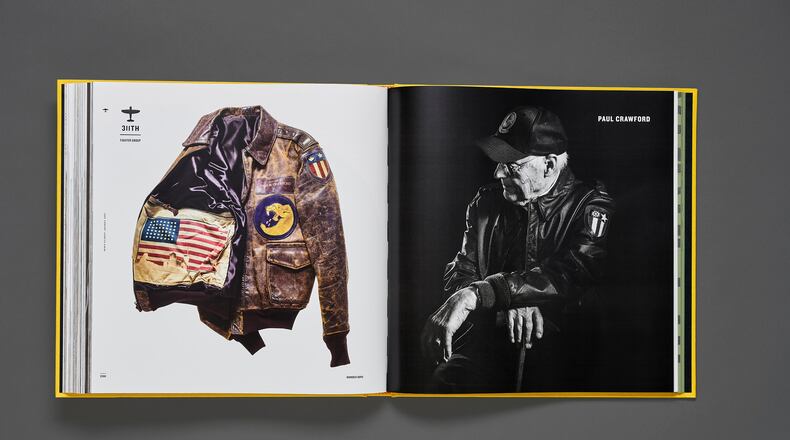One of the stories my family likes to tell is about my father lying about his age to join the Navy during World War II. A country boy born in Cordele, he set sail to north Africa at the tender age of 15. He became a quartermaster whose battle station was to provide communications between the combat control center on the bridge and the gunner’s mate. He fought in both the Atlantic and Pacific theaters, and was in Tokyo Bay when the peace treaty was signed ending the war.
My father died two years ago at age 94. Among his possessions that I ended up with is his old crackerjack-style Navy uniform that’s still in shockingly good condition. As much as I treasure it, I have no idea what to do with it. But every so often I take it out of the closet to look at it, marveling at how small it is and how thick and scratchy the wool is.
Credit: John Slemp
Credit: John Slemp
So when photographer John Slemp’s coffee table book “Bomber Boys: WWII Flight Jacket Art” crossed my desk, I was intrigued. I know firsthand how sentimental people can be about their World War II garments. After all, they are tangible pieces of history.
Nearly 200 pages long, the book is beautifully designed and features exquisitely photographed full-color images of 104 flight jackets, most now owned by museums but some still belonging to individuals. In addition, there are dozens of portraits of WWII veterans and their war stories.
The book is filled with interesting tidbits of information. The jackets were originally made from horse hide, but later cow and goat hide were also used. Depending on the manufacturer, the color could range from nearly black to brown to rust. And they were designed to have no side pockets because hands in pockets was considered unmilitary.
Credit: JOHN SLEMP
Credit: JOHN SLEMP
But what makes the jackets so spectacular is the way they were individualized with patches, stencils and especially paint. Many of the jackets sport works of art on their backs. In bright colors, some rendered in airplane paint, the illustrations depict airplanes, cartoon figures, scantily clad women, nicknames, hometowns — plus scores and scores of bomb silhouettes to signify the number of missions flown.
Slemp, 68, is a Tucker resident who knows a little something about the military. Born in Japan, he is the son of a Green Beret who served two tours of duty in Vietnam, and Slemp served 11 years in the Army as an armor officer. That’s where he first learned photography. After the service he studied at the Portfolio Center in Atlanta and became a commercial photographer.
The book has been a passion project since 2014, born out of a job he got shooting portraits of WWII veterans heading to France for the Normandy invasion anniversary. He got the idea to photograph an old flight jacket — he thought it might make a good blog post. On a lark, he sent the pictures to a friend at the Smithsonian, who told Slemp the institution had 15 jackets he could shoot. The project mushroomed from there.
Credit: T.Sicurezza
Credit: T.Sicurezza
“As I started doing this, I started hearing the stories of the veterans, too, so I thought, now I gotta do some portraits,” he said. “I really wanted to know more about these guys and their service and what they did and if they had any interesting stories, which of course they did.”
Before long, Slemp said, “it started coalescing in my mind that this could be a book.”
Unable to interest a traditional publisher, John used his personal savings to hire his own graphic designer and publish it himself.
“I knew what I wanted to have in the book. I knew that I didn’t want to have it watered down, and I wanted to have control over the content. And I wanted it published in my lifetime, so I said, the heck with it.”
The result is a gorgeous and fascinating look at a monumental moment in history featuring the heroism of a generation that is slipping away from us and deserves to be remembered forever.
“Bomber Boys” is available at wwiibomberboys.com, Amazon, TallTales Bookshop, Atlanta History Center museum shop and Wine & Whimseys in Tucker.
Suzanne Van Atten is a book critic and contributing editor to The Atlanta Journal-Constitution.
About the Author
Keep Reading
The Latest
Featured





